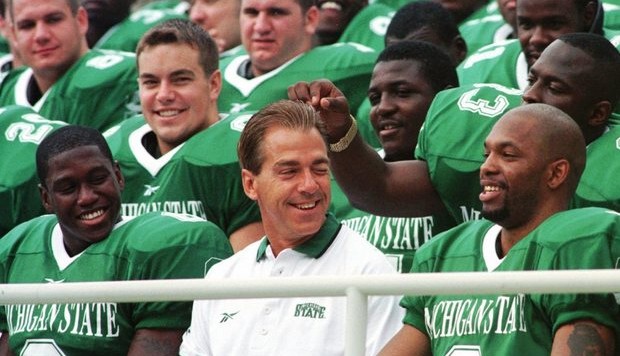It was a very good Saturday for Nick Saban.
See that photo above? That’s Saban taking the team picture with the 1998 Michigan State Spartans.
The 1998 Spartans did not possess championship aspirations, and they did not fulfill them. Michigan State lingered in — if not obscurity — “second-class status” for quite some time following the 1988 Rose Bowl win over USC under George Perles. Mediocre in some seasons and teasingly “almost there” in others, Michigan State established an identity as a member of the “not yet” club in college football.
In 1998, that’s where Saban stood himself.
Then a less-than-remarkable coach, Saban had not yet moved to Baton Rouge, where he launched his ascendancy at LSU. “The Hound” (if Alabama has “The Bear,” Saban is The Hound) was toiling in the middle tiers of college football; he had not left any sort of imprint on the sport…
… not until November 7, 1998, that is.
Saban’s Michigan State team waltzed into Columbus and defeated what might have been John Cooper’s best and most talented team at Ohio State. This was the only game the Buckeyes lost in 1998; they steam rolled Texas A&M in the Sugar Bowl, but in a pre-playoff world, they didn’t get to play their way into a national championship game.
Nick Saban denied the Buckeyes, putting the first notch on his belt as a big-game coach:
Today, 17 years after that conquest, Saban must have privately marveled and fist-pumped (though perhaps without smiling) as his former employer once again put the first “L” in an Ohio State loss column. Yes, this Michigan State team will deserve to make the College Football Playoff if it manages to win out. Clearly, the 2015 Spartans — when taken as a whole — are far better than the 1998 version. However, a Michigan State team forced to play the entire 2015 season without Connor Cook would almost surely be closer to the 6-6 record of the 1998 Spartans. More precisely, MSU would be closer to 6-6 than it would be to 10-1 under such a circumstance.
What Mark Dantonio did on Saturday — as he dashed Ohio State’s dreams of going unbeaten for the second time in three seasons — rates every bit as highly as Saban’s work on November 7, 1998.
The nuance which rises to the forefront: Whereas John Cooper was a notoriously weak big-game coach in Columbus, current Ohio State boss Urban Meyer is anything but. The Buckeyes had won 30 straight Big Ten regular season games under Meyer (not counting conference title games, hence the streak; Michigan State beat OSU in the 2013 league championship game in Indianapolis). OSU did produce an unbeaten season in 2012 and might have reached the national championship game had athletic director Gene Smith played his cards better in 2011. Meyer’s body of work at Florida (two national titles) and Utah (an unbeaten season and top-five ranking), combined with his resume at Ohio State, makes him one of the two best coaches in this sport on an annual basis.
While Meyer’s opponent this upcoming Saturday — Jim Harbaugh — and Florida State’s Jimbo Fisher deserve a place at the table when “superstar coaches” are discussed, the top two consists of Meyer and Nick Saban over a longer period of time. This should not be in dispute.
How far is the reach of these two men over the past 15 seasons of college football?
Between the two, Meyer and Saban have won seven of the past 14 SEC titles. They have won seven of the past 14 national titles. They have won three of the past four national championships and six of the past nine. None of this diminishes what Fisher has done at Florida State, or what Harbaugh has done at Stanford and is in the process of doing at Michigan; it merely shows how much these two men — especially with Pete Carroll now a receding memory, safely tucked away in the NFL — have towered over the sport.
Saban just watched Meyer falter, while his own Alabama team closes in on another SEC West title; a league championship; and a spot in another playoff.
Moreover — and most of all — Saban won’t have to coach against Meyer should the Crimson Tide get to the playoff. He will clearly be the best coach in a playoff (though Dantonio would sure make for a strong and compelling No. 2 choice).
It’s pretty good to be Nick Saban right now. By several historical measurements — and in the long-term race with Urban Meyer (the Federer-Nadal comparison of college football coaching today) — Saban just took a few big steps forward on Nov. 21, 2015.
It’s almost as satisfying as Nov. 7, 1998, had to feel for The Hound of college football history.

